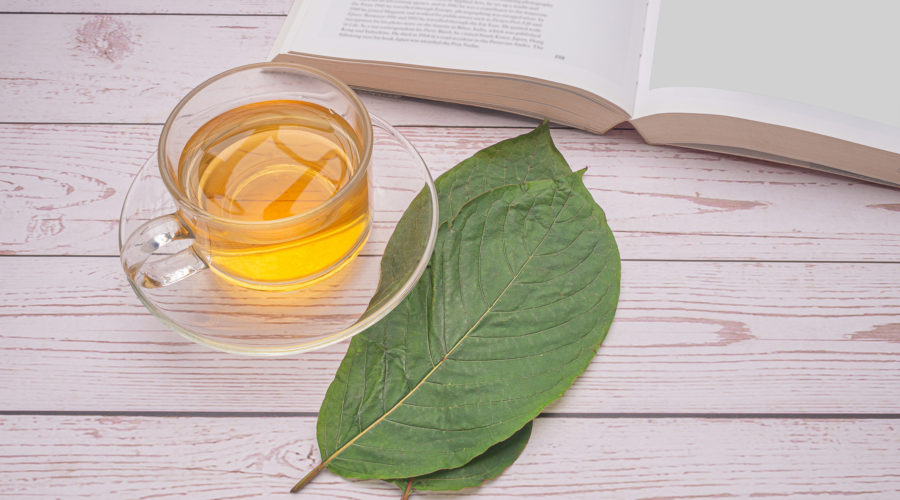What Is Kratom Tea Good For, And How Do You Make It?
Kratom refers to the leaves of the plant Mitragyna speciosa, which belongs to the coffee plant family Rubiaceae. It has a long history of use in Southeast Asia, where it has been used for various medical purposes, as well as its stimulant effects. The plant is native to Indonesia, Malaysia, and Thailand.
Kratom also goes by other names, including Maeng Da, ketum, biak-biak, thom, thang, and kakum.
Traditionally, field workers would chew on kratom leaves to help increase their energy and endurance, aid their heat tolerance, and relieve fatigue.
Kratom leaves have traditionally been chewed, crushed and brewed into a tea, or smoked. Nowadays, they are ground and used to make pills and kratom powders.
In recent years, the use of kratom has gained popularity. But what is kratom tea good for? Well, many people enjoy it for its natural pain-relieving properties and ability to elevate mood. But there are many other benefits beyond these that are worth exploring.
RELATED: CBD & Kratom
What Is Kratom Tea?
Kratom tea is traditionally made by brewing the leaves of Mitragyna speciosa, which can be either fresh or dried and ground up into a powder.
Kratom Tea Effects
The compounds found in kratom act upon various receptors in the brain, causing effects similar to those of stimulants and opioid pain relievers, depending on the dosage.
In small doses between 1-5g, kratom acts as a stimulant and appears to increase energy, causing people to feel more alert and social.
In higher doses between 5-15 g, kratom appears to have a sedative effect, similar to that of opioid pain relievers, such as morphine and codeine. This effect causes people to feel tired, calm, and euphoric.
In doses higher than 15 g, kratom’s sedative effects become more pronounced and may cause someone to lose consciousness.
Kratom leaves used to make kratom tea contain more than 40 active compounds, but mitragynine and 7-hydroxymitragynine are the two main ones. These are the ones responsible for kratom’s effects.
It’s worth highlighting that kratom leaves from different parts of Southeast Asia have varying levels of mitragynine. Malaysian kratom leaves have a much lower concentration at 12 percent, while the figure is 66 percent for Thai kratom leaves.
Health Benefits: What Is Kratom Tea Good For?
Although many health bloggers have suggested kratom tea offers health benefits, there is very little reliable evidence to support these claims.
One 2017 survey suggests that kratom use may alleviate pain, and might relieve the symptoms of anxiety and depression. However, keep in mind that surveys are based on self-reporting, which makes them more easily prone to bias.
Researchers behind one 2020 paper state the following:
“While kratom is most commonly known for its affinity for mu-opioid receptors, research has shown one of its active components has effects on the same receptors to which some antipsychotics bind, such as D2 dopamine, serotonin (5-HT2C and 5-HT7), and alpha-2 adrenergic receptors displaying possible indications of kratom to be used as both antipsychotics and antidepressants.
“Although studies to evaluate this effect are still lacking, several online and in-person surveys note relief of depression and anxiety symptoms among those who consume kratom products, and in fact identify it as a common reason for consumption. This then highlights the dire need for further research to be conducted on kratom, its mechanism of action and the constituents that elicit these antidepressant, anxiolytic, and antipsychotic properties.”
Other users have claimed that kratom tea might help with symptoms of opioid withdrawal. This is because kratom contains the compounds mitragynine and 7-hydroxymitragynine, which interact with the opioid receptors in the brain.
Animal studies have shown that kratom may improve opioid tolerance and opioid withdrawal in mice. However, this does not necessarily mean that similar effects would occur in people.
Since kratom has opioid-like effects, due to the presence of mitragynine, kratom tea may also help relieve chronic pain.
Some people use kratom to improve their sexual performance and enhance their physical endurance. However, more extensive and high-quality studies are needed to understand these mechanisms.
Traditionally, kratom has been used as a herbal remedy to treat various ailments, including coughing, diarrhea, diabetes, and high blood pressure. But again, we need more research to better understand these possible benefits.
Is Kratom Tea Safe?
The Food and Drug Administration (FDA) has not approved kratom tea or kratom-based products for any medical purpose.
In some European countries, including Denmark, Lithuania, Poland, Latvia, Romania, and Sweden, the possession and use of kratom are controlled. Other countries that control kratom under their narcotic laws include Malaysia, Myanmar, Australia, and New Zealand.
One reason why kratom is restricted in so many countries is that there is no evidence showing that the plant is safe or effective for health purposes. In fact, there is data that has led to concerns about the safety and abuse potential of kratom.
Kratom does have the potential to be abused, and it can be addictive. Moreover, there is a link between kratom and serious health consequences, including death.
One 2019 review of data from the National Poison Data system found that more than 2,312 people have reported that kratom made themselves or someone else ill. There have also been 44 reported deaths linked to kratom use (although most of these involved kratom products laced with other ingredients).
It’s important to note that the FDA does not monitor or regulate the dosage or purity of kratom products, so they may not contain exactly what is listed on their labels.
Kratom Tea Side Effects
The use of kratom may bring various side effects, including:
- Dehydration
- Constipation
- Loss of appetite
- Weight loss
- Anorexia
- Nausea
- Increased urination
- Seizures
- Psychosis
- Hallucinations
Kratom can cause dependence and addiction, like morphine and codeine can, due to its opioid-like effects. This is why you may experience withdrawal symptoms when you stop taking it.
Symptoms of kratom withdrawal include:
- Muscle aches
- Jerky movements
- Insomnia
- Irritability
- Hostility
- Aggression
- Emotional changes
- Runny nose
RELATED: Kratom Withdrawal: Symptoms, Experiences, And Timeline
How Long Does Kratom Stay In Your System?
A small dose of kratom tea (made with powder) starts showing its effects in around 10-15 minutes. The effects of higher doses may last up to eight hours. The peak effects tend to last for 1.5-2.5 hours after consumption.
It takes one day for your body to eliminate half of the kratom you consumed and five days to completely drain it out from your body. But this depends on your body’s metabolism.
How To Make Kratom Tea
What You Need:
- 3 cups of water
- Kratom powder
- Sweetener (e.g. sugar or agave syrup)
Process:
- Bring the water to a boil in a saucepan.
- Remove the water from the stove and add the kratom powder. Reduce heat and simmer for 15 minutes. You can steep the tea for a shorter period for a mild tea.
- Strain out the kratom powder.
- Add your sweetener of choice to the tea.
- Serve at room temperature.
- You can also make iced tea by adding ice cubes.
Alternatives To Kratom Tea
If you have any concerns about using kratom tea due to its potential side effects and the risk of addiction, there are alternatives.
Drinking coffee is likely to be a much safer stimulant choice than kratom tea. There is a lot of research on coffee, with one review describing coffee consumption as mostly harmless.
In fact, the review even suggests that high coffee consumption can be beneficial to people’s health. It may lower your risk of developing certain cancers, as well as neurological, liver, and metabolic conditions.
As for opioid withdrawal, many over-the-counter medications are effective in helping with its effects. Unlike kratom tea, doctors and scientists fully understand these medications.
In terms of reducing symptoms of depression and anxiety, there are many alternatives to consider, including:
- Regular exercise
- Dietary changes
- Improved sleep hygiene
- Meditation
- Ketamine therapy
- Psychedelic therapy
- TMS therapy
- CBD
For relief of chronic pain, there is an increasing body of evidence suggesting that microdoses of classic psychedelics and ketamine can be helpful. While CBD is commonly marketed as an effective chronic pain reliever (analgesic), there is a lack of high-quality scientific evidence regarding this connection.
The Bottom Line
Kratom tea is made from kratom leaves that are steeped in boiling water. It has stimulant or opioid-like effects, depending on the dosage.
Kratom has been used and consumed by Southeast Asian people for a long time, renowned for its energizing properties, helping people to start their day. The true health benefits of kratom are unknown. However, many users say it is effective at alleviating pain and improving mental health.
Though it’s legal in the United States, the Drug Enforcement Agency (DEA) considers kratom a drug of concern due to its potential to lead to abuse, addiction, and even death. Its use is regulated in many other countries for the same reasons.
Although some health gurus profit from creating excitement around natural remedies (like kratom), it’s important to follow the science when thinking about alternative treatments.
If you are at all worried about the side effects and risks of consuming kratom tea, there are safer, more evidence-based options available. If you decide to use kratom tea and notice any side effects, you should limit your consumption and seek medical advice.



